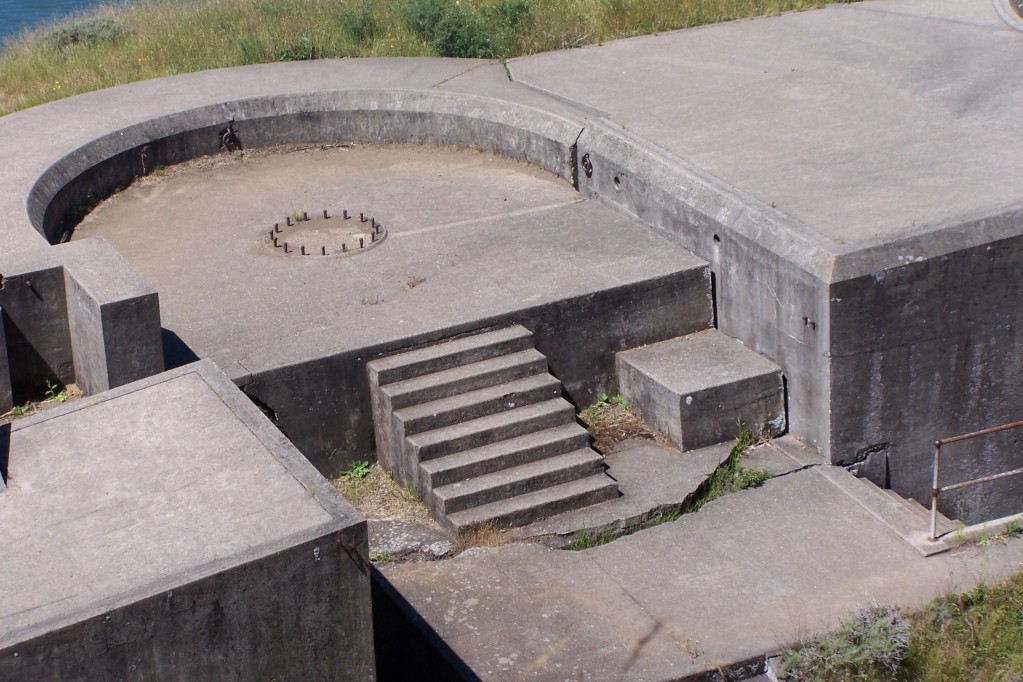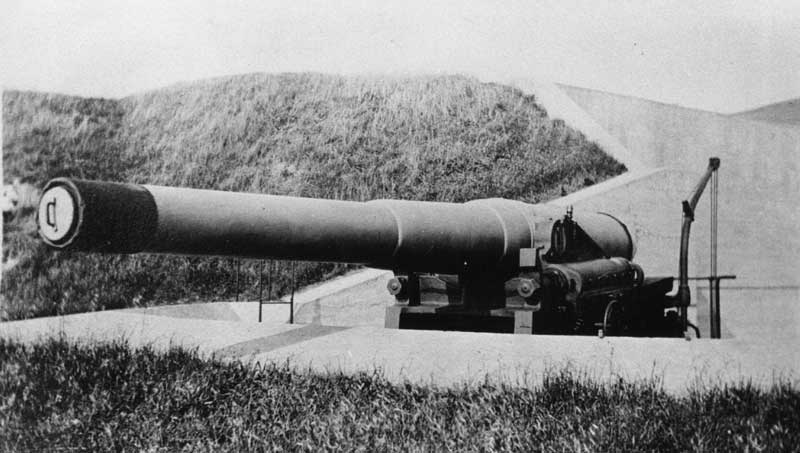
Battery Ledyard, erected on the site of the old Point Knox Civil War battery, and armed with two five-inch rapid-fire guns.
In 1885 US President Grover Cleveland appointed a joint army, navy and civilian board, headed by Secretary of War William C. Endicott, known as the Board of Fortifications. The findings of the board illustrated a grim picture of existing defenses in its 1886 report and recommended a massive $127 million construction program of breech-loading cannons, mortars, floating batteries, and submarine mines for some 29 locations on the US coastline.
Prior efforts at harbor defense construction had ceased in the 1870s. Since that time the design and construction of heavy ordnance advanced rapidly, including the development of superior breech-loading and longer-ranged cannon, making the US harbor defenses obsolete. In 1883, the navy had begun a new construction program with an emphasis on offensive rather than defensive warships. These factors combined to create a need for improved coastal defense systems.
The Endicott Board’s recommendations would lead to a large scale modernization program of harbor and coastal defenses in the United States, especially the construction of modern reinforced concrete fortifications and the installation of large caliber breech-loading artillery and mortar batteries. Typically, Endicott period projects were not fortresses, but a system of well-dispersed emplacements with few but large guns in each location. The structures were usually open-topped concrete walls protected by sloped earthworks. Many of these featured disappearing guns, which sat protected behind the walls, but could be raised to fire. Mine fields were a critical component of the defense, and smaller guns were also employed to protect the mine fields from mine sweeping vessels.
In April of 1898 work began on Angel Island’s first permanent Endicott Battery, Battery Drew, located just south of Camp Reynolds and armed with a single eight-inch M1888 breech loading rifle on an M1892 barbette (non-disappearing) carriage. The battery was named in G.O. 16, 14 Feb 1902 after 1st Lt. Alfred W. Drew, 12th U.S. Infantry, who was killed in action at Angles, Luzon, Philippine Islands, 19 Aug 1899. Construction on this new battery began just three weeks before the start of the Spanish-American War—the war gave impetus to the construction, just as the Civil War had for the original batteries. was completed in 1898 and transferred to the Coastal Artillery for use 1 May 1900 at a cost of $ 34,836.82. Deactivated in 1915.
The second new battery was Battery Ledyard, which was erected on the site of the old Point Knox Civil War battery, and armed with two five-inch rapid-fire guns. The battery was named in S.O. 16, 14 Feb 1902 after 1st Lt. August C. Ledyard, 6th U.S. Infantry, who was killed in action on the Island of Negros, Philippine Islands, on 8 Dec 1899. Battery construction started and was completed in 1900. The battery was transferred to the Coastal Artillery for use 1 Aug 1900 at a cost of $ 20,044.58. Deactivated in 1915 when the guns and carriages were removed.
The third, and last, battery in the series was Battery Wallace, built above and behind Ledyard, and armed with a single eight-inch rifle on a disappearing carriage. The battery was named in G.O. 16, 14 Feb 1902 after 1st Lt. Robert B. Wallace, 2nd U.S. Cavalry, who died 13 Mar 1900 of wounds received in action at Caloocan, Luzon, Philippine Islands, on 10 Feb 1899. Battery construction started in 1899, was completed in 1900 and transferred to the Coastal Artillery for use 1 Aug 1900 at a cost of $40,420.42. Deactivated in 1915.

Battery Drew. A rare photograph of the 8-inch breech-loading rifle on a non-disappearing carriage at Battery Drew, one of the three Endicott Batteries built on the island between 1898 and 1902. The gun was removed some time after WWI – the emplacement still exists on Martar Hill, on the south side of the island. Circa 1915.

Battery Drew, one of three Endicott batteries built on Angel Island. Construction on this battery began in 1898, completed in 1900. An eight-inch M1888 breech loading rifle on an M1892 barbette (non-disappearing) carriage. Decommissioned in 1915.
 Following the Civil War the artillery batteries on Angel Island were allowed to decay. This smartly dressed threesome is relaxing in front of three deteriorating 32-pounders at Point Stuart. Circa 1880
Following the Civil War the artillery batteries on Angel Island were allowed to decay. This smartly dressed threesome is relaxing in front of three deteriorating 32-pounders at Point Stuart. Circa 1880
Our Community. Our Island. Our Legacy.
Angel Island Conservancy// PO Box 866 / Tiburon / CA 94920// info@angelisland.org// Tax ID No. 51-0152954// FACEBOOK// FLICKR// INSTAGRAM